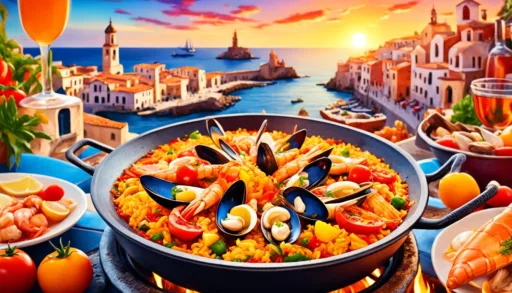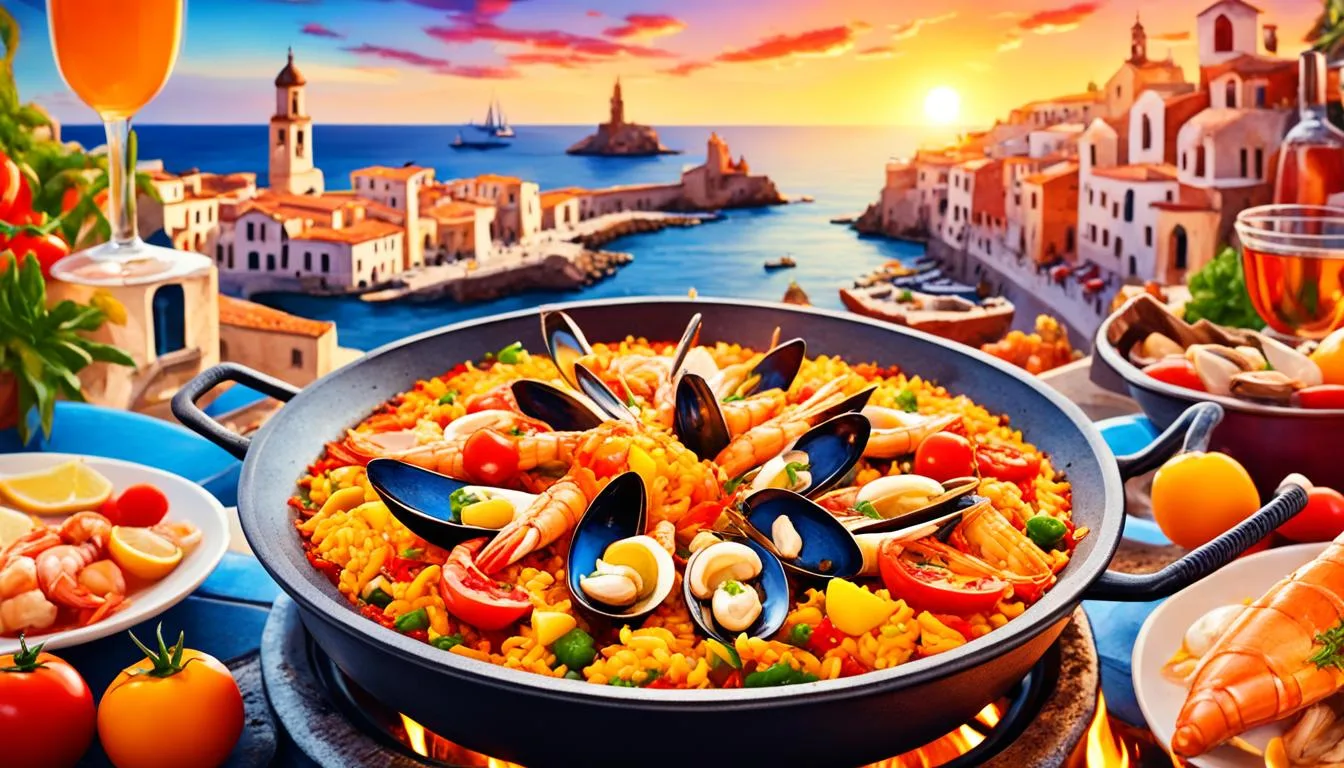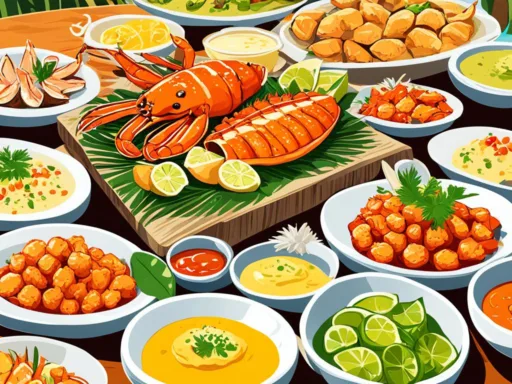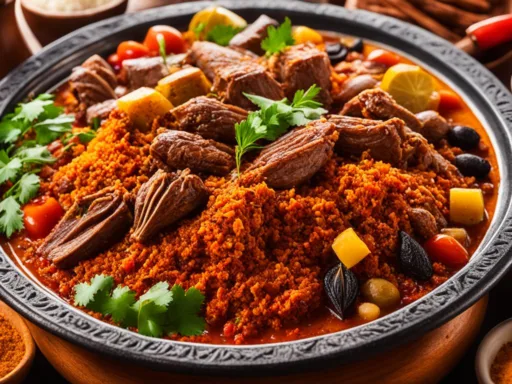Embark on a tantalizing journey through the multifaceted Spanish food culture, where each region serves up its own slice of gastronomic heaven. Spanish Food Discoveries go much beyond paella and tapas; it’s an epicurean adventure through authentic Spanish cuisine that tantalizes the taste buds and warms the soul. From the robust flavors of traditional Spanish dishes in the northern canticles to the sweet whispers of Andalusia’s desserts, explore the rich tapestry of Spain’s culinary offerings. Let your senses dance to the rhythm of a diverse heritage etched into every bite, as Spain invites you to feast not just on food, but on culture itself. Are you ready to indulge in the heart and soul of genuine Spanish cooking?
Key Takeaways
- Spanish Food Discoveries reveal the country’s rich tapestry of gastronomy, deeply intertwined with its cultural landscapes.
- Authentic Spanish cuisine offers far more than globally known dishes, presenting regional specialties that tell the story of Spain’s diverse geography and history.
- Traditional Spanish dishes serve as culinary ambassadors for Spain’s distinct regions, reflecting local heritage and time-tested cooking techniques.
- The allure of Spanish food culture lies in its power to unite tradition and innovation, giving rise to an ever-evolving yet rooted culinary identity.
- Engaging with Spanish cuisine provides a multitude of sensory experiences, from robust mountain stews to delicate coastal treats.
The Rich Tapestry of Spanish Gastronomy Highlights
Spain’s culinary canvas is a vibrant one, painted with a variety of Spanish gastronomy highlights that distinctly embody the nation’s cultural richness. This enchanting journey through taste buds begins in the fertile Asturian valleys, home to the hearty Fabada Asturiana, and sweeps through the bustling streets of Barcelona, where the flavorful Bombas reign supreme.
However, it is not only the dishes themselves that captivate food enthusiasts but also the exemplary raw ingredients that are staple to Mediterranean food specialties. Spain, the renowned breadbasket of olive oil, generously drizzles this golden elixir over its culinary masterpieces, enriching flavors and bringing a wholesome essence to each meal.
From the verdant groves of Andalusia to the salty shores of Valencia, every region contributes its verse to the epic poem of Spanish culinary traditions.
Let’s not overlook Spain’s gift to the food world, Iberico ham – a delectable treasure made from pigs raised on a rich diet of acorns. This delicacy, along with other fresh produce like sun-ripened tomatoes and zesty citrus fruits, creates a symphony of tastes that resonate with authenticity.
- Olive oil – the heart of Spanish cooking and a valuable export.
- Iberico ham – exclusive acorn-fed pork that epitomizes Spanish flavor.
- Fresh produce – including heirloom tomatoes, oranges, and lemons which are prominently featured in daily meals.
- Seafood and meats – locally sourced, celebrating the diversity of Spain’s regions.
- Cheeses – a variety of regional offerings that range from sharp Manchego to creamy Cabrales.
Moving beyond the ingredients, Spain’s dining scene offers an authentic taste of these culinary treasures in venues that range from quaint, family-operated restaurants to world-class, Michelin-starred establishments. Cities like Girona are not only rich in history but also in flavors, offering both residents and visitors a true taste of gastronomic excellence.
In summary, the bounty of Spanish gastronomy is an ongoing feast for the senses, weaving together the tapestry of traditional dishes and the specialty ingredients that position Spain as a beacon of Mediterranean culinary prestige.
Savoring Traditional Spanish Dishes Region by Region
Embarking on a gastronomic tour of Spain is akin to flipping through the pages of a vibrant, delicious history book. Each regional cuisine of Spain offers a story, a snapshot of the cultural and topographical influences that have shaped the nation’s diverse Spanish food culture. Travelers and food enthusiasts alike are intrigued by the opportunity to savor traditional Spanish dishes, seeking the authenticity that comes from enjoying culinary delights in their place of origin.

Imagine, if you will, the tapestry of Spain’s regions as a dining table, with each geographical area bringing its distinctive flavors to the feast. The northern mountains of Asturias are home to Fabada Asturiana, a robust stew perfect for the cooler climate, while the southern reaches of Andalusia might offer a refreshing gazpacho to temper the Mediterranean sun. Madrid, the heartbeat of Spain, boasts simple yet satisfying dishes like Bocadillo de Calamares that reflect the city’s fast-paced yet traditional lifestyle.
In the coastal havens, seafood reigns supreme. Galicia proudly serves Pulpo a la gallega, tender octopus prepared with paprika, rock salt, and a drizzle of olive oil. No exploration of traditional Spanish dishes would be complete without the region’s heralded Torta de Santiago, a dessert that pays homage to the area’s rich religious history.
Each dish, each flavor is a testament to the Spanish food culture, a heritage that locals are passionate to share. The act of dining goes beyond satiety—it’s about experiencing the pride of place that these meals represent. With every bite, visitors find themselves more connected to this vibrant, storied country.
- Catalonia: Renowned for its diverse flavors from the rugged Pyrenees to the sun-kissed Mediterranean coast, dishes range from Escudella, a hearty winter stew, to the delicate flavors of Crema Catalana.
- Basque Country: Offering unique culinary gems like Pinxtos, the Basque version of tapas, and the singular Bacalao al Pil Pil, a salty cod delight.
- Valencia: The birthplace of paella, Valencia showcases the region’s abundant rice fields and coastal seafood, creating a dish that’s now a global symbol of Spanish cuisine.
As one delves deeper into the flavors of Spain, the unity and diversity of its cuisine emerge as a celebration of both regional specificity and collective identity. Each traditional Spanish dish becomes more than just food; it becomes an edible narrative, eloquently expressing the story of a land rich in history and flavor. Thus, the journey through the regional cuisine of Spain is not merely about consumption; it’s an adventure, taste-by-taste, into the very soul of Spanish culture.
Spanish Tapas Favorites: A Bite-sized Culinary Adventure
Embark on a flavorful exploration of Spanish tapas favorites, where each morsel is a testament to the rich tapestry of traditional Spanish dishes. Immersed within the convivial essence of Spanish food culture, tapas are not merely food items; they are a cherished facade of Spain’s social and culinary heritage. The allure of these bite-sized delights lies in their ability to bring people together, fostering an environment that enhances the joy of sharing and tasting a variety of dishes in unison.
Exploring the Variety of Spanish Tapas
The variety of tapas available across Spain is staggering. Each region contributes to a delectable mosaic of flavors and textures that embody the spirit of Spanish gastronomy. Tapas range from the simple to the sublime, showcasing ingredients from the humble potato to the luxurious cured Iberico ham. Take, for example, the ever-popular patatas bravas, a dish of fried potatoes served with a spicy tomato sauce, or the delicate balance of flavors in gambas al ajillo, shrimp cooked in a sizzling garlic-infused oil. Such dishes not only satiate appetites but also ignite curiosity in those hungry for authentic Spanish flavors.
The Social Aspect of Tapas Culture
Tapas culture is synonymous with Spain’s gregarious lifestyle, where each bite-sized dish serves as a catalyst for conversation and camaraderie. Far more than a culinary convenience, tapas embody a dining philosophy that prioritizes social interaction and shared experience. Whether gathered in a bustling Barcelona bodega or a serene Seville tavern, Spaniards and travelers alike revel in the communal delight of tapas, turning every meal into a memorable social event.
| Tapas | Region | Key Ingredients | Flavor Profile |
|---|---|---|---|
| Patatas Bravas | Throughout Spain | Potatoes, Tomato Sauce, Spices | Savory and spicy |
| Gambas al Ajillo | Throughout Spain | Shrimp, Garlic, Olive Oil | Rich and garlicky |
| Pa amb Tomàquet | Catalonia | Bread, Tomato, Olive Oil, Salt | Fresh and simple |
| Jamón Iberico | Extremadura, Andalusia | Cured Iberico Ham | Complex and nutty |
| Tortilla Española | Throughout Spain | Eggs, Potatoes, Onion, Olive Oil | Rustic and hearty |
In quintessentially Spanish fashion, the tradition of tapas extends beyond the confines of the kitchen, shaping itself around the number 5 pillars of Spanish social life: camaraderie, diversity, flavor, heritage, and innovation. The resulting experience is a woven tapestry of taste and togetherness, representative of Spain’s unwavering commitment to communal dining and culinary mastery.
Spanish Food Discoveries: A Sea of Flavors
Embark on a sumptuous voyage with Spanish Food Discoveries, where the vibrant diversity of traditional Spanish dishes mingles harmoniously with the delectable richness of Mediterranean food specialties. Along Spain’s extensive coastline, each harbor, market, and seaside village contributes to a grand tapestry of maritime culinary excellence.
One of the most cherished gifts from the sea is Seville’s espinacas con garbanzos, a flavorful blend infused with Atlantic elements, combining leafy greens and hearty pulses in a dish that has long captured the essence of culinary craftsmanship in southern Spain. Meanwhile, the milder Mediterranean waters offer Catalonia’s prized calçots—tender, charred, and often served with a rich, nutty romesco sauce that seduces the palate. These authentic offerings showcase the freshness and quality of ingredients that distinguish Spain’s food traditions and reveal the depth of the nation’s penchant for combining land and sea.
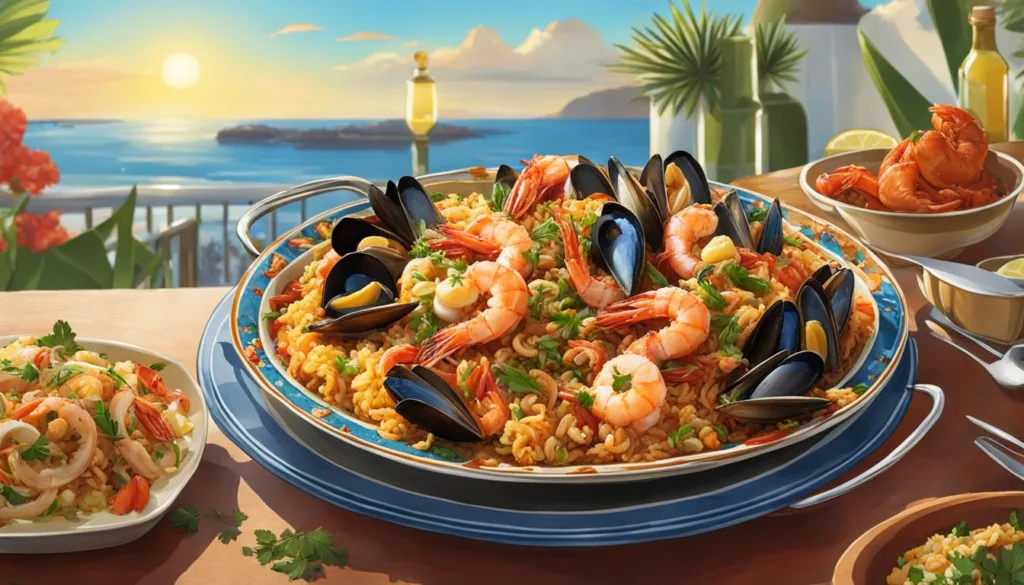
The adventurous foodie finds solace in Spain’s seafood extravagance, each mouthful a euphonious ballet of tastes and textures. From the tender octopus of pulpo a la gallega to the lauded shellfish paellas, there is a story in every bite, a narrative spun from recipes woven into the fabric of Spain’s gastronomic identity.
Discover the breadth of Spain’s culinary seascape, where tradition sails upon the tides of innovation, buoyed by an eternal love affair with flavor.
- Atlantic coast treasures like Galicia’s pulpo a la gallega
- Andalusian gambas al ajillo, a dance of shrimp and garlic
- Valencia’s iconic seafood paellas, a symphony of rice and ocean bounty
As the sun casts its last golden glow over the horizons of Spain’s bountiful coasts, it paints the faces of those who gather to feast, reminded that Spanish culinary discoveries are not just meals—they are medleys of culture, history, and community, served with a side of unforgettable seaside ambience.
Authentic Spanish Cuisine: Paella, Cochinillo, and Beyond
Embark on a delicious exploration of authentic Spanish cuisine that tantalizes the senses and honors the rich legacies of Spanish culinary traditions. From the fertile groves of Valencia to the historic ovens of Segovia, you’ll uncover the essence of Spain’s gastronomy. The journey through its vibrant culinary landscape reveals the sheer magnificence of traditional Spanish dishes that are coveted across the globe.
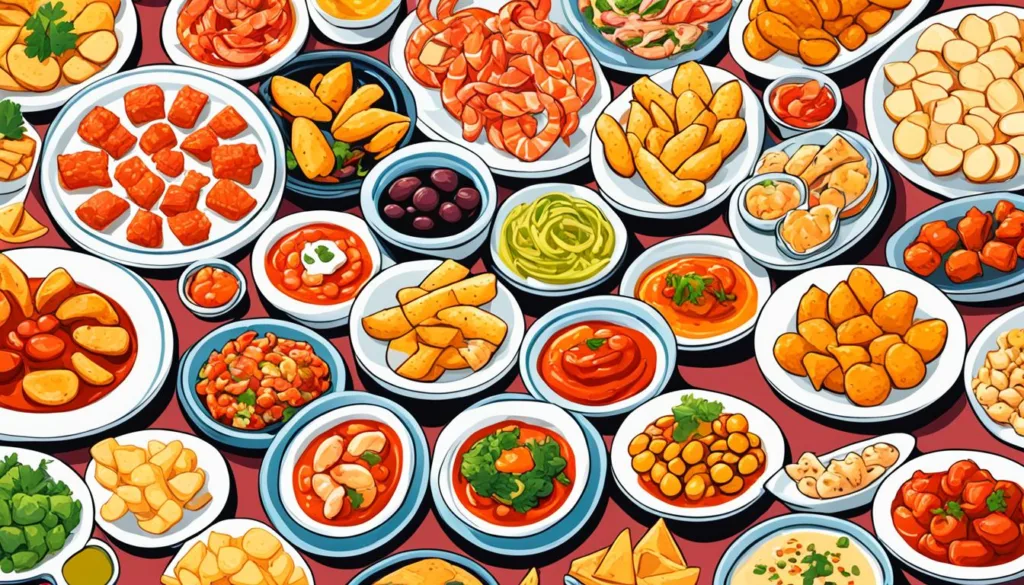
Unlocking the Secrets of Paella
Under the Spanish sun, the iconic dish of paella is not just a meal; it’s a cultural artifact befitting the seventh art. Practical and poetic, the Valencian creation is a harmonious symphony of local rice, rich saffron, and a repertoire of ingredients ranging from rabbit and snails to the freshest catch from the azure waters. Dive into the secrets of its preparation and understand why paella is more than food—it’s a narrative of the land and its people, a testament to authentic Spanish cuisine.
The Delicacy of Cochinillo Asado
As we turn our gaze towards Segovia, the aroma of roasting meat whispers the tales of ancestral kitchens where cochinillo asado is revered. This ancient delicacy, with its golden crispy skin and melt-in-mouth tenderness, stands as the epitome of traditional Spanish dishes. In the city’s aged eateries, the hallowed ovens have seen the generational passing of the baton, securing the posterity of Spanish culinary traditions.
| Traditional Dish | Origin | Main Ingredients | Unique Cooking Technique |
|---|---|---|---|
| Paella Valenciana | Valencia | Rice, rabbit, chicken, green beans, saffron | Socarrat (caramelized bottom layer) |
| Cochinillo Asado | Segovia | Suckling pig, seasoning | Roasted in wood-fired ovens |
Best Spanish Restaurants: From Local Eateries to Michelin Stars
When it comes to experiencing the best Spanish restaurants, food lovers are spoilt for choice. The landscape of Spanish gastronomy is as varied as it is exceptional, offering a delightful mix of family-owned taverns and lavish, Michelin-starred venues. With an appreciation for the ingredients fresh from the Mediterranean Sea and an unwavering commitment to culinary excellence, these establishments have carved out a reputation for providing an unrivaled dining experience.
The mark of a great Spanish restaurant lies not only in the prestige of its chefs but also in the authenticity of its cuisine. Through a fusion of Spanish gastronomy highlights and Mediterranean food specialties, these eateries provide a passport to the soul of Spain’s culinary heart.
| Restaurant | Location | Specialty | Mediterranean Influence |
|---|---|---|---|
| El Celler de Can Roca | Girona | Contemporary Catalan | Fresh local seafood, traditional olive oils |
| Asador Etxebarri | Axpe | Grilled Cuisine | Wood-fired grill, seasonal vegetables |
| Aponiente | El Puerto de Santa María | Seafood Innovation | Marine flavors, sustainable catch |
| Casa Duque | Segovia | Cochinillo Asado | Traditional Castilian cooking method |
Whether you’re indulging in the savory roast of Casa Duque’s cochinillo asado or exploring the modernist creations of El Celler de Can Roca, you’re engaging with centuries of Spanish culinary craft. Each restaurant offers an enchanting ambiance where diners can immerse themselves in the cultural tapestry that is uniquely Spanish.
“To eat in Spain is to taste the essence of its rich history and to partake in a sacred ritual of flavors that has been passed down through generations.”
Today’s discerning food enthusiasts look not only for flavor but also for an epicurean narrative that tells the story of the land, its people, and its customs. Within the walls of Spain’s top restaurants, such stories are told with every dish, making each meal not just an act of eating, but a moment in time to be treasured.
Mediterranean Food Specialties: The Heart of Spanish Cooking
Embarking on a culinary adventure through Spain, one can’t help but be enchanted by the robust influence of Mediterranean food specialties. The tapestry of flavors woven into the fabric of Spanish culinary traditions celebrates a rich harvest of the Mediterranea’s bounty. A cornerstone of this beloved diet is the emphasis on eating foods that are as good for the soul as they are for the body.
Healthy and Flavorful: The Mediterranean Diet
Recognized as a UNESCO Intangible Cultural Heritage, the Mediterranean diet is a testament to a lifestyle that marries longevity with pleasure. Spain’s adherence to this diet showcases a delectable array of fresh vegetables, fruits, legumes, and nuts, all dressed in the liquid gold that is olive oil. The health benefits of following this heart-healthy diet include reduced risks of heart disease and a celebration of longevity, which is as much part of the Spanish tradition as siestas and fiestas. The bedrock of nutrition, paired with succulent flavors, ensures that every meal is not just consumption but a Spanish Food Discovery.
Celebrating Seafood and Olive Oil
Moreover, Spanish tables are graced with an impressive selection of seafood, reflecting the nation’s expertise in harnessing the sea’s bounty. Dishes like “pescaíto frito”, a joyous expression of Andalusia’s love affair with fried fish, and Galicia’s “pulpo a la gallega”, where octopus is granted new life with paprika and olive oil, stand as culinary beacons. No conversation about Mediterranean food specialties is complete without acknowledging Spain’s pivotal role in cultivating olive oil, a cherished ingredient that elevates a humble bread to a divine treat. Drizzled, dipped, or cooked—olive oil is the eternal companion to Spanish gastronomy.
Spanish Culinary Traditions Through the Ages
The rich tapestry of Spanish culinary traditions is a vibrant narrative of flavors and techniques, refined over centuries by a myriad of cultural influences. From the Romans to the Moors, each civilization left its mark, imparting a distinctive essence to what we now celebrate as the hallmarks of Spanish gastronomy.
Historical Influences on Spanish Cuisine
The confluence of historical events has painted a dynamic picture of Spanish gastronomy highlights. The Romans brought olive cultivation, the Arabs introduced a variety of spices, and the discovery of America saw the introduction of tomatoes, potatoes, and chocolate to Spanish cooking—each contributing to the kaleidoscope of tastes within the Spanish kitchen.
Regional Specialties Rooted in Tradition
A journey through Spain’s diverse regions uncovers a gastronomic landscape where each territory preserves its own traditional Spanish dishes. From the hearty Fabada of Asturias to the exquisitely roasted cochinillo of Segovia, the country’s regional dishes are a testament to Spain’s enduring food culture and the communal nature of its culinary experiences.
What’s remarkable is that within each locality lies a story, an ancestral recipe, and an unwavering commitment to authenticity, making Spain a treasure trove for Spanish Food Discoveries. Each dish, with its unique blend of ingredients and historical importance, offers not just sustenance, but also a taste of Spain’s spirited past and innovative future. These are the flavors that have cemented Spain’s reputation on the world stage and make up an essential chapter in the script of global cuisine.
Conclusion: The Infinite Journey of Spanish Cuisine Discovery
The exploration of Spanish Food Discoveries unfolds like an undying narrative, rich with the heritage of flavors that have been simmering across the ages. From the rustic warmth of authentic Spanish cuisine in a village tavern to the avant-garde presentations in the bustling cities, every bite is a chapter in a grand tale. The canvas of Spain’s gastronomical history is dotted with recipes that have traveled through time, telling stories of conquest, fusion, and innovation.
Embarking on this epicurean expedition through Spanish culinary traditions is a commitment to understanding more than just food. It’s an understanding of a culture that prides itself on diversity, a reflection of their colorful history, ingrained in every saffron thread and olive oil drizzle. Regions speak through their dishes, with each locale offering an intimate taste of Spain’s spirit and legacy. It is an infinite journey, indeed, where each destination reveals a new facet of Spanish gastronomy’s jewels.
As one navigates through Spain’s vast gastronomic terrain, it is clear that the quest for culinary enlightenment is perpetual. For the humble food lover or the seasoned gourmet, there is always more to discover, more to taste, and more to relish. Spain, with its robust flavors and dynamic traditions, remains an open invitation to the world, to delve deeper into the quintessence of its taste and tradition — a timeless adventure of Spanish cuisine discovery.
